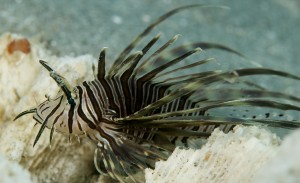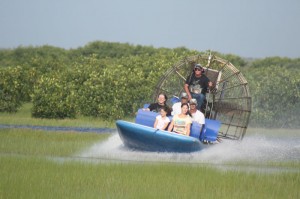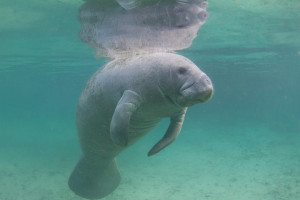 The Everglades is full of both native and, unfortunately, invasive, species. Whether they were let loose or escaped, these species found their way into the Everglades and are having a negative impact on the ecosystem.
The Everglades is full of both native and, unfortunately, invasive, species. Whether they were let loose or escaped, these species found their way into the Everglades and are having a negative impact on the ecosystem.
One of these invasive species is the lionfish. Despite being bad for the Everglades’ ecosystem, a lionfish is an attractive looking fish with its pectoral fins, brownish stripes.
As an invasive species, the lionfish can live and thrive in habitats that are not their true home or region. The lionfish is a venomous predator and its original habitat is from Indo-Pacific waters.
Unlike pythons, lionfish are not the biggest problem yet in the Everglades, but their numbers are increasing each year. In 2014, 13 lionfish were removed from Everglades.
Although the not large in numbers in the Everglades, the lionfish population is growing in nearby waters. It is believed more will appear in the area and in the Everglades. Currently, there is a“Everglades and Dry Tortugas Lionfish Management Plan” in review that will target specific areas within each park to help suppress lionfish from entering.
The lionfish was introduced to the Atlantic waters around the 1980s. It is believed this fish made its way here either through aquarium trade or through ballast water on international boats. These lionfish can live in water anywhere from 1 to 1,000 feet in mangroves, seagrass, coral, hard bottom, and artificial reefs.
It is believed they could have a real big impact on the marine ecosystems here in south Florida. Their presence will decrease the number of native and commercial species. Although it doesn’t happen often, their stings are also known to be painful and can lead to serious injury.
Here are some ways lionfish are bad for the Everglades:
- They feed primarily on larvae and juvenile fish.
- They eat and consume a great variety of fishes and crustaceans
- They eat herbivorous fish that graze on algae.
With this behavior, the number of fish will dwindle, there will be less fish in the water and less fish for other predators to eat; also with more algae around, the algae can overgrow and keep coral and sponges from growing and thriving.
Right now, the lionfish is the only known invasive marine fish recognized at having invaded the entire Caribbean and coastal waters around southeastern United States. These fish are slow moving and easy to capture. Netting and spearing are usually used to capture them.
Book a Ride on an Airboat through Everglades
If you’re visiting the Everglades and spot a lionfish, report it! You can tell one of our guidesif you spot a lionfish on a tour or call the Park at 305-809-4738 or 305-562-0820.
Although they are a “pretty” fish, it’s a good thing to remove them from this ecosystem so they don’t do it more harm.
To book a tour, all Captain Mitch’s Airboat Tours at 800-368-0065 or visit our Everglades Airboat Tours page.
Captain Mitch’s Everglades Airboat Tours are open seven days a week 8:30 a.m. to 4 p.m. If paying by cash, adults cost $40 (plus tax) and children 12 and under cost $20 (plus tax. If paying by credit card, adults cost $45 (plus tax) and children cost $25 (plus tax).
 As many people know, the Everglades’ ecosystem is struggling. Between human development, invasive species, and Mother Nature, this area has been through a lot, and it needs help to restore itself back to its original, healthy s
As many people know, the Everglades’ ecosystem is struggling. Between human development, invasive species, and Mother Nature, this area has been through a lot, and it needs help to restore itself back to its original, healthy s Th
Th Did you know adult manatees can eat up to 10 to 15% of their body weight daily? That’s a lot of food! To get in that much food, manatees graze
Did you know adult manatees can eat up to 10 to 15% of their body weight daily? That’s a lot of food! To get in that much food, manatees graze 





